Comparison of the Efficiency and Load Power in Periodic Wireless Power Transfer Systems with Circular and Square Planar Coils
Abstract
:1. Introduction
2. Wireless Power Transfer System Consisting of Periodically Distributed Planar Coils
2.1. Description of the Analyzed Models of Wireless Power Transfer System
2.2. Numerical Approach to the Analysis of the Periodic WPT System
2.3. Analytical Approach to the Analysis of WPT System
3. Analytical and Numerical Results
3.1. Analyzed Models
- -
- Operation with maximum efficiency, where the optimal load impedance was described as follows.
- -
- Operation with maximum transferred power, where the optimal load impedance was described as follows.
3.2. System Operating with Maximum Efficiency
3.2.1. Maximum Power Transfer Efficiency for Small Coil (r = 10 mm)
3.2.2. Maximum Power Transfer Efficiency for Large Coil (r = 25 mm)
3.3. System Operating with Maximum Load Power
3.3.1. Results of the Maximum Load Power for Small Coil (r = 10 mm)
3.3.2. Results of the Maximum Load Power for Large Coil (r = 25 mm)
4. Conclusions
- (1)
- For small coil (r = 10 mm):
- n = 15: 8% (h = 0.5 r), 19% (h = r);
- n = 25: 4% (h = 0.5 r), 12% (h = r);
- n = 35: 3% (h = 0.5 r), 8% (h = r);
- n = 45: 2% (h = 0.5 r), 7% (h = r).
- (2)
- For large coil (r = 25 mm):
- n = 40: 3% (h = 0.5 r), 13% (h = r);
- n = 50: 2% (h = 0.5 r), 10% (h = r);
- n = 60: 2% (h = 0.5 r), 7% (h = r);
- n = 70: 1% (h = 0.5 r), 5% (h = r);
- n = 80: 1% (h = 0.5 r), 5% (h = r).
Author Contributions
Funding
Institutional Review Board Statement
Informed Consent Statement
Data Availability Statement
Conflicts of Interest
List of Symbols and Abbreviations
| A | Magnetic vector potential (Wb/m) |
| C | Capacity (F) |
| c1, c2, c3, c4 | Coil geometry coefficients (-) |
| d | Outer cell dimensions (m) |
| dm | Mean diameter of a coil (m) |
| f | Frequency (Hz) |
| h | Vertical distance between coils (m) |
| i | Wire insulation thickness (m) |
| Ir | Complex receiver current (A) |
| It | Complex transmitter current (A) |
| It,∞ | Complex source current at Zl = ∞ (A) |
| Jext | External current density (A/m2) |
| Lc | Inductance of a coil (H) |
| Lself | Self-inductance of a coil (H) |
| lsum | Total length of a wire (m) |
| M | Mutual inductance between coils (H) |
| n | Number of turns (-) |
| nsurf | Normal vector |
| Po | Active load power (W) |
| Pz | Active source power (W) |
| r | Coil radius (m) |
| Rc | Resistance of a coil (Ω) |
| Ur,∞ | Complex receiver voltage at Zl = ∞ (V) |
| Ut | Amplitude of voltage source (V) |
| w | Wire diameter (m) |
| Ze | Load impedance to achieve maximum efficiency (Ω) |
| Zl | Load impedance (Ω) |
| Zp | Load impedance to achieve maximum load power (Ω) |
| η | Power transfer efficiency (%) |
| μ0 | Permeability of air (H/m) |
| ν | Fill coefficient of a coil (-) |
| σ | Electrical conductivity (S/m) |
| 3D | Three-dimensional |
| EM | Electromagnetic |
| FDFD | Finite-difference frequency-domain |
| FDTD | Finite-difference time-domain |
| FEM | Finite element method |
| IPT | Inductive power transfer |
| NDOF | Number of degrees of freedom |
| PBC | Periodic boundary conditions |
| PEEC | Partial element equivalent circuit |
| PML | Perfectly matched layers |
| Rx | Receiver |
| Tx | Transmitter |
| WPT | Wireless power transfer |
References
- Sołjan, Z.; Hołdyński, G.; Zajkowski, M. Balancing reactive compensation at three-phase four-wire systems with a sinusoidal and asymmetrical voltage source. Bull. Pol. Acad. Sci. Tech. Sci. 2020, 68, 71–79. [Google Scholar]
- Sun, L.; Ma, D.; Tang, H. A review of recent trends in wireless power transfer technology and its applications in electric vehicle wireless charging. Renew. Sustain. Energy Rev. 2018, 91, 490–503. [Google Scholar] [CrossRef]
- Luo, Z.; Wei, X. Analysis of Square and Circular Planar Spiral Coils in Wireless Power Transfer System for Electric Vehicles. IEEE Trans. Ind. Electron. 2018, 65, 331–341. [Google Scholar] [CrossRef]
- Li, X.; Zhang, H.; Peng, F.; Li, Y.; Yang, T.; Wang, B.; Fang, D. A wireless magnetic resonance energy transfer system for micro implantable medical sensors. Sensors 2012, 12, 10292–10308. [Google Scholar] [CrossRef] [PubMed]
- Fitzpatrick, D.C. Implantable Electronic Medical Devices; Academic Press: San Diego, CA, USA, 2014; pp. 7–35. [Google Scholar]
- Wei, X.; Wang, Z.; Dai, H. A critical review of wireless power transfer via strongly coupled magnetic resonances. Energies 2014, 7, 4316–4341. [Google Scholar] [CrossRef] [Green Version]
- Barman, S.D.; Reza, A.W.; Kumar, N.N.; Karim, M.E.; Munir, A.B. Wireless powering by magnetic resonant coupling: Recent trends in wireless power transfer system and its applications. Renew. Sustain. Energy Rev. 2015, 51, 1525–1552. [Google Scholar] [CrossRef]
- Li, S.; Mi, C.C. Wireless power transfer for electric vehicle applications. IEEE J. Emerg. Sel. Top. Power Electron. 2015, 3, 4–17. [Google Scholar]
- Zhong, W.; Lee, C.K.; Hui, S.Y.R. General analysis on the use of Tesla’s resonators in domino forms for wireless power transfer. IEEE Trans. Ind. Electron. 2013, 60, 261–270. [Google Scholar] [CrossRef] [Green Version]
- Alberto, J.; Reggiani, U.; Sandrolini, L.; Albuquerque, H. Fast calculation and analysis of the equivalent impedance of a wireless power transfer system using an array of magnetically coupled resonators. PIER B 2018, 80, 101–112. [Google Scholar] [CrossRef] [Green Version]
- Stankiewicz, J.M.; Choroszucho, A.; Steckiewicz, A. Estimation of the Maximum Efficiency and the Load Power in the Periodic WPT Systems Using Numerical and Circuit Models. Energies 2021, 14, 1151. [Google Scholar] [CrossRef]
- Wang, B.; Yerazunis, W.; Teo, K.H. Wireless Power Transfer: Metamaterials and Array of Coupled Resonators. Proc. IEEE 2013, 101, 1359–1368. [Google Scholar] [CrossRef]
- IEEE. IEEE Standard for Safety Levels with Respect to Human Exposure to Radio Frequency Electromagnetic Fields, 3 kHz to 300 GHz. IEEE Std C95.1™-2005, April; IEEE: Piscataway, NJ, USA, 2006. [Google Scholar]
- Christ, A.; Douglas, M.G.; Roman, J.M.; Cooper, E.B.; Sample, A.P.; Waters, B.H.; Smith, J.R.; Kuster, N. Evaluation of wireless resonant power transfer systems with human electromagnetic exposure limits. IEEE Trans. Electromagn. Compat. 2013, 55, 265–274. [Google Scholar] [CrossRef]
- Madawala, U.K.; Thrimawithana, D.J. A bidirectional inductive power interface for electric vehicles in V2G systems. IEEE Trans. Ind. Electron. 2011, 58, 4789–4796. [Google Scholar] [CrossRef]
- Zhang, W.; Wong, S.-C.; Tse, C.K.; Chen, Q. Analysis and comparison of secondary series-and parallel-compensated inductive power transfer systems operating for optimal efficiency and load-independent voltage-transfer ratio. IEEE Trans. Power Electron. 2014, 29, 2979–2990. [Google Scholar] [CrossRef]
- Kurs, A. Power Transfer through Strongly Coupled Resonances; MIT: Cambridge, MA, USA, 2007; pp. 38–40. [Google Scholar]
- Kurs, A.; Karalis, A.; Moffatt, R.; Joannopoulos, J.D.; Fisher, P.; Soljačić, M. Wireless power transfer via strongly coupled magnetic resonances. Science 2007, 317, 83–86. [Google Scholar] [CrossRef] [PubMed] [Green Version]
- Kurs, A.; Moffatt, R.; Soljačić, M. Simultaneous mid-range power transfer to multiple devices. Appl. Phys. Lett. 2010, 96, 044102. [Google Scholar] [CrossRef]
- Yoon, I.-J.; Ling, H. Investigation of near-field wireless power transfer in the presence of lossy dielectric materials. IEEE Trans. Antennas Propag. 2013, 61, 482–488. [Google Scholar] [CrossRef]
- Imura, T.; Hori, Y. Maximizing air gap and efficiency of magnetic resonant coupling for wireless power transfer using equivalent circuit and Neumann formula. IEEE Trans. Ind. Electron. 2011, 58, 4746–4752. [Google Scholar] [CrossRef]
- Cheon, S.; Kim, Y.-H.; Kang, S.-Y.; Lee, M.L.; Lee, J.-M.; Zyung, T. Circuit-model-based analysis of a wireless energy-transfer system via coupled magnetic resonances. IEEE Trans. Ind. Electron. 2011, 58, 2906–2914. [Google Scholar] [CrossRef]
- Hoang, H.; Lee, S.; Kim, Y.; Choi, Y.; Bien, F. An adaptive technique to improve wireless power transfer for consumer electronics. IEEE Trans. Consum. Electron. 2012, 58, 327–332. [Google Scholar] [CrossRef]
- Cannon, B.L.; Hoburg, J.F.; Stancil, D.D.; Goldstein, S.C. Magnetic resonant coupling as a potential means for wireless power transfer to multiple small receivers. IEEE Trans. Power Electron. 2009, 24, 1819–1825. [Google Scholar] [CrossRef] [Green Version]
- Sample, A.P.; Meyer, D.A.; Smith, J.R. Analysis, experimental results, and range adaptation of magnetically coupled resonators for wireless power transfer. IEEE Trans. Ind. Electron. 2011, 58, 544–554. [Google Scholar] [CrossRef]
- Hoang, H.; Bien, F. Maximizing efficiency of electromagnetic resonance wireless power transmission systems with adaptive circuits. Wirel. Power Transf. Princ. Eng. Explor. 2011, 11, 207–225. [Google Scholar]
- Duong, T.P.; Lee, J.-W. Experimental results of high-efficiency resonant coupling wireless power transfer using a variable coupling method. IEEE Microw. Wirel. Compon. Lett. 2011, 21, 442–444. [Google Scholar] [CrossRef]
- Park, B.-C.; Lee, J.-H. Adaptive impedance matching of wireless power transmission using multi-loop feed with single operating frequency. IEEE Trans. Antennas Propag. 2014, 62, 2851–2856. [Google Scholar]
- Beh, T.C.; Kato, M.; Imura, T.; Oh, S.; Hori, Y. Automated impedance matching system for robust wireless power transfer via magnetic resonance coupling. IEEE Trans. Ind. Electron. 2013, 60, 3689–3698. [Google Scholar] [CrossRef]
- Awai, I.; Komori, T. A simple and versatile design method of resonator-coupled wireless power transfer system. In Proceedings of the 2010 International Conference on Communications, Circuits and Systems, ICCCAS 2010—Proceedings, Chengdu, China, 28–30 July 2010; pp. 616–620. [Google Scholar]
- Lee, W.-S.; Son, W.-I.; Oh, K.-S.; Yu, J.-W. Contactless energy transfer systems using antiparallel resonant loops. IEEE Trans. Ind. Electron. 2013, 60, 350–359. [Google Scholar] [CrossRef]
- Steckiewicz, A.; Stankiewicz, J.M.; Choroszucho, A. Numerical and Circuit Modeling of the Low-Power Periodic WPT Systems. Energies 2020, 13, 2651. [Google Scholar] [CrossRef]
- Alberto, J.; Reggiani, U.; Sandrolini, L.; Albuquerque, H. Accurate calculation of the power transfer and efficiency in resonator arrays for inductive power transfer. PIER 2019, 83, 61–76. [Google Scholar] [CrossRef] [Green Version]
- Wang, B.; Teo, K.H.; Yamaguchi, S.; Takahashi, T.; Konishi, Y. Flexible and Mobile Near-Field Wireless Power Transfer Using an Array of Resonators. IEICE Technical Report, WPT2011-16. 2011. Available online: https://citeseerx.ist.psu.edu/viewdoc/download?doi=10.1.1.375.3846&rep=rep1&type=pdf (accessed on 11 August 2021).
- Steckiewicz, A. High-frequency cylindrical magnetic cloaks with thin layer structure. J. Magn. Magn. Mater. 2021, 534, 168039. [Google Scholar] [CrossRef]
- Taflove, A.; Hagness, S.C. Computational Electrodynamics: The Finite—Difference Time—Domain Method; Artech House: Boston, MA, USA, 2005. [Google Scholar]
- Zienkiewicz, O.C.; Taylor, R.L.; Zhu, J.Z. The Finite Element Method: It’s Basis & Fundamentals, 7th ed.; Butterworth-Heinemann: Oxford, UK, 2013. [Google Scholar]
- Crimele, V.; Torchio, R.; Villa, J.L.; Freschi, F.; Alotto, P.; Codecasa, L.; di Rienzo, L. Uncertainty Quantification for SAE J2954 Compliant Static Wireless Charge Components. IEEE Access 2020, 8, 171489–171501. [Google Scholar] [CrossRef]
- Crimele, V.; Torchio, R.; Virgillito, A.; Freschi, F.; Alotto, P. Challenges in the Electromagnetic Modeling of Road Embedded Wireless Power Transfer. Energies 2019, 12, 2677. [Google Scholar] [CrossRef] [Green Version]
- Mohan, S.S.; del Mar Hershenson, M.; Boyd, S.P.; Lee, T.H. Simple Accurate Expressions for Planar Spiral Inductances. IEEE J. Solid-State Circuits 1999, 34, 1419–1424. [Google Scholar] [CrossRef] [Green Version]

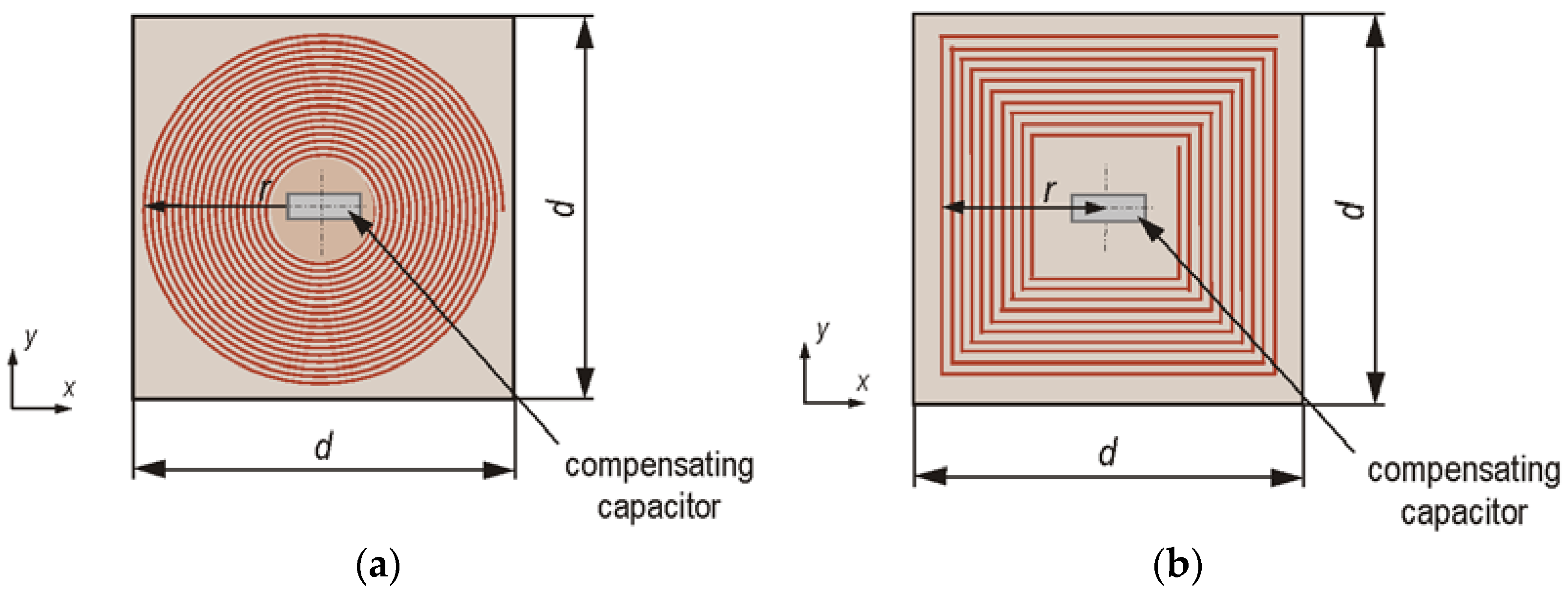

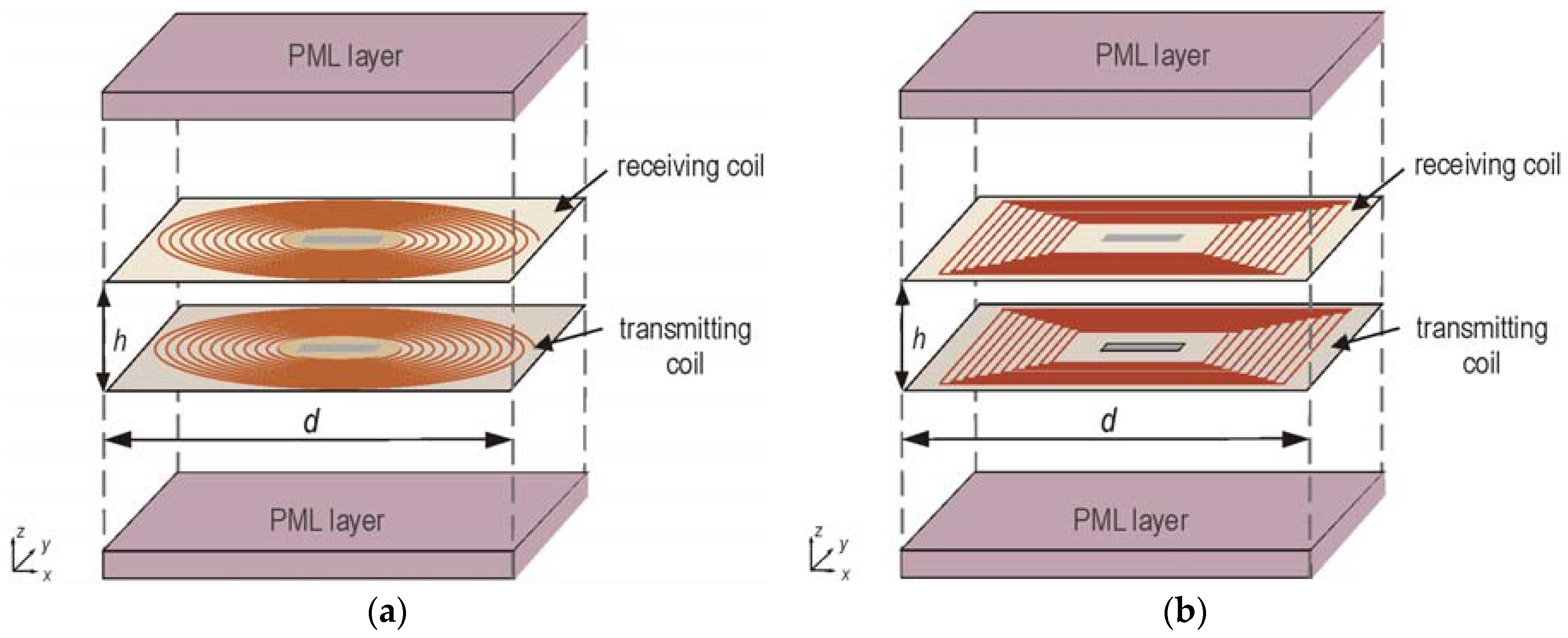

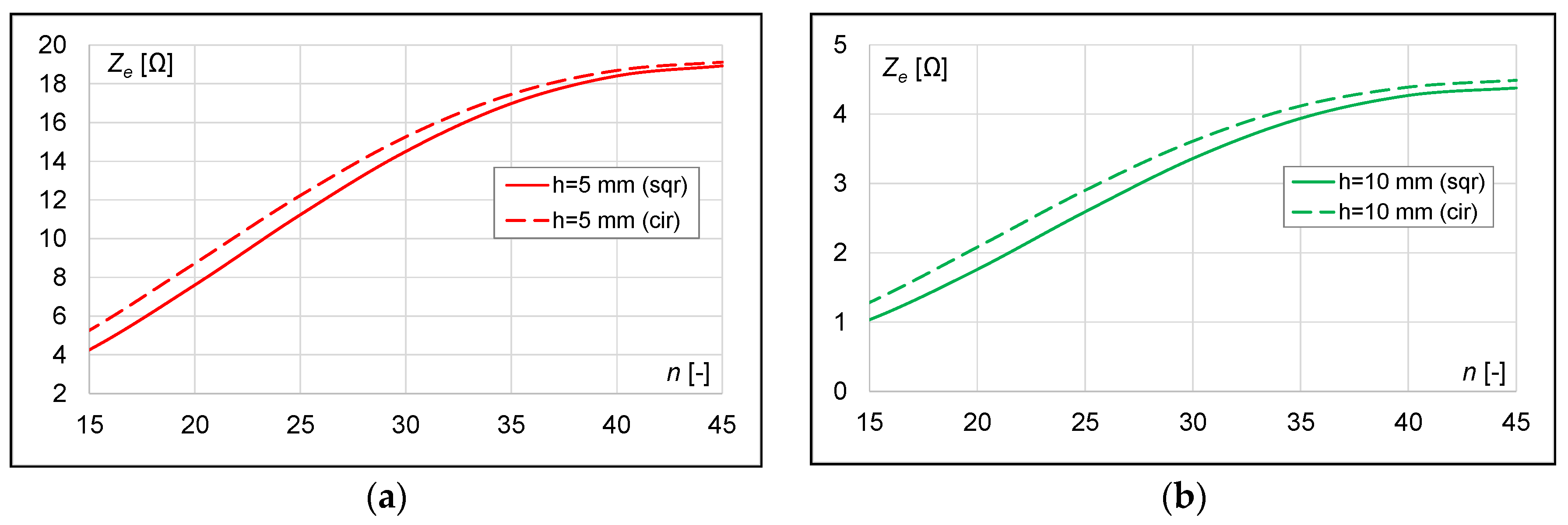
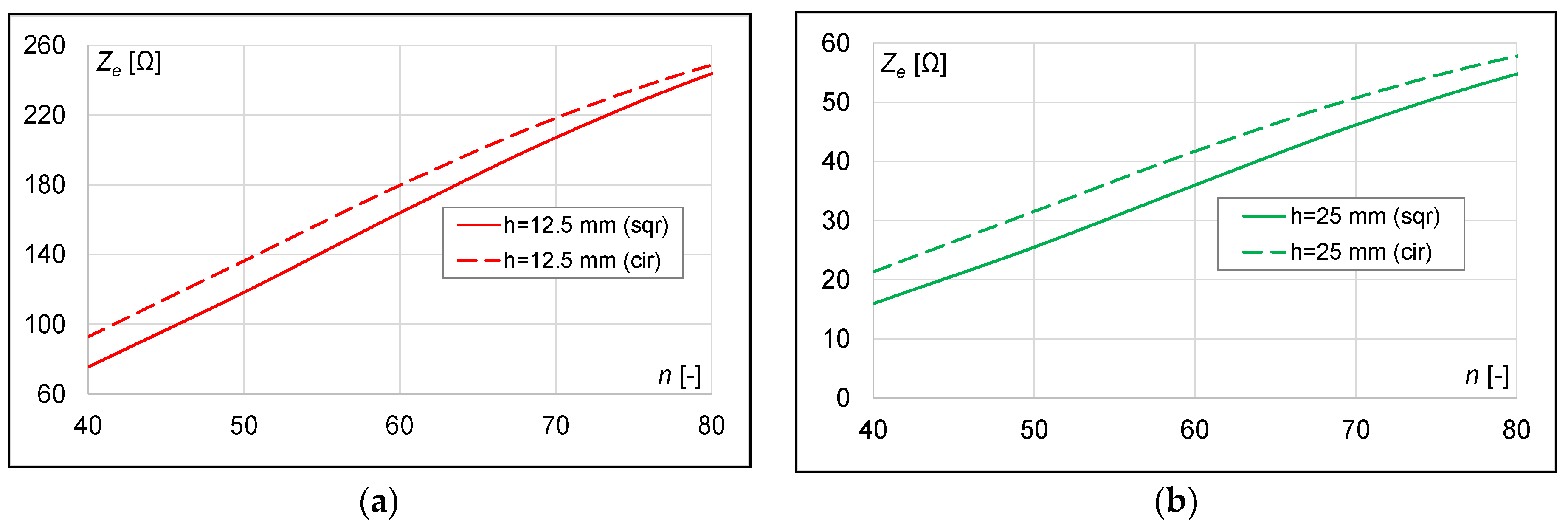









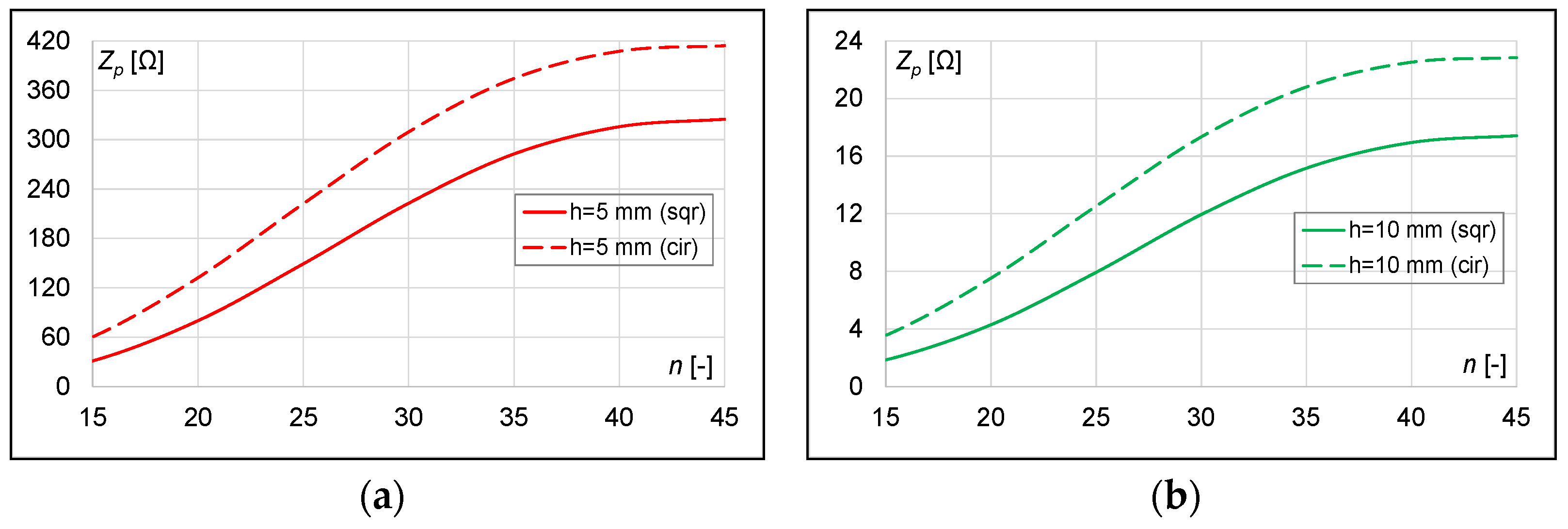
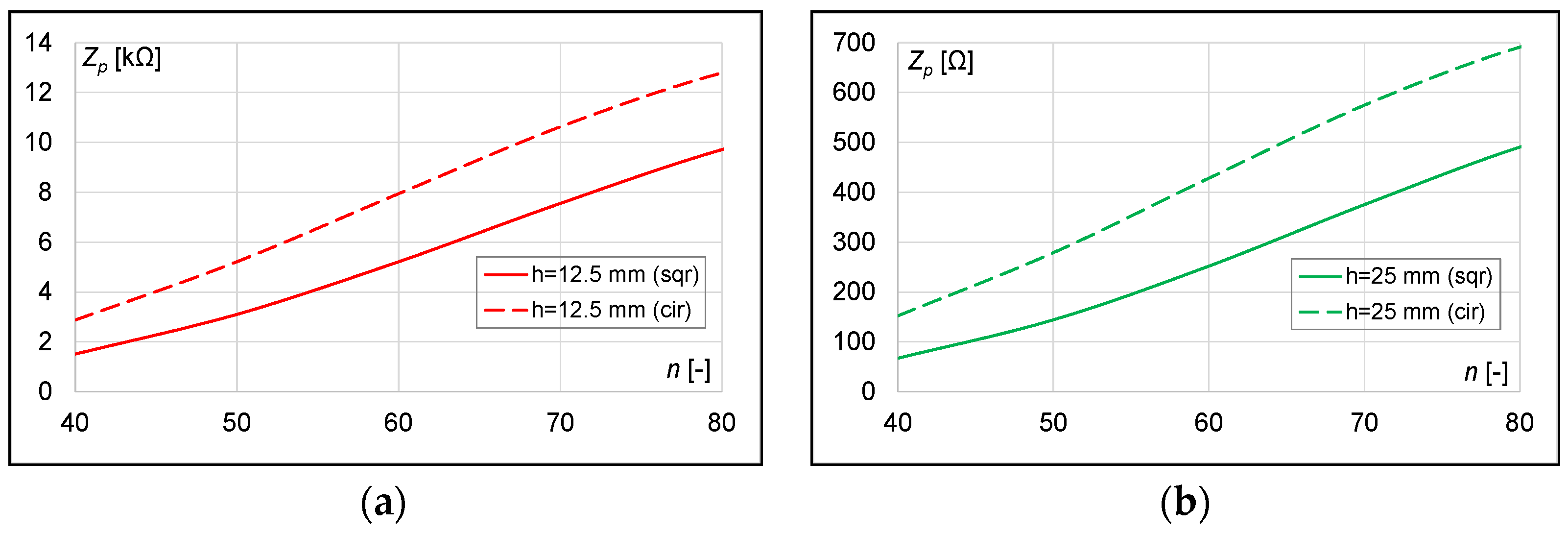









| Type of Coil | Coefficient | |||
|---|---|---|---|---|
| c1 | c2 | c3 | c4 | |
| Circular coil | 1.0 | 2.5 | 0 | 0.2 |
| Square coil | 1.46 | 1.9 | 0.18 | 0.13 |
| r (mm) | n | h (mm) | |
|---|---|---|---|
| 0.5 r | r | ||
| 10 | 15 | 5.0 | 10.0 |
| 25 | 5.0 | 10.0 | |
| 35 | 5.0 | 10.0 | |
| 45 | 5.0 | 10.0 | |
| 25 | 40 | 12.5 | 25.0 |
| 50 | 12.5 | 25.0 | |
| 60 | 12.5 | 25.0 | |
| 70 | 12.5 | 25.0 | |
| 80 | 12.5 | 25.0 | |
| Parameter | Symbol | Value |
|---|---|---|
| Diameter of the wire | w | 200 µm |
| Thickness of the wire insulation | i | 5 µm |
| Conductivity of the wire (copper) | σ | 5.6 × 107 S/m |
| n | Lself (μH) | C at fmax (nF) | Ze (Ω) at fmax | Zp (Ω) at fmax | Mtr (μH) | |||
|---|---|---|---|---|---|---|---|---|
| h = 0.5 r | h = r | h = 0.5 r | h = r | h = 0.5 r | h = r | |||
| 15 | 6.29 | 5.07 | 5.27 | 1.28 | 61 | 3.56 | 0.84 | 0.19 |
| 25 | 11.72 | 2.64 | 12.23 | 2.90 | 222 | 12.53 | 1.94 | 0.45 |
| 35 | 15.40 | 1.96 | 17.46 | 4.12 | 374 | 20.81 | 2.78 | 0.64 |
| 45 | 16.70 | 1.79 | 19.12 | 4.49 | 414 | 22.84 | 3.04 | 0.70 |
| n | Lself (μH) | C at fmax (pF) | Ze (Ω) at fmax | Zp (Ω) at fmax | Mtr (μH) | |||
|---|---|---|---|---|---|---|---|---|
| h = 0.5 r | h = r | h = 0.5 r | h = r | h = 0.5 r | h = r | |||
| 40 | 107 | 293 | 93 | 21.37 | 2881 | 152 | 14.79 | 3.37 |
| 50 | 143 | 219 | 137 | 31.54 | 5219 | 279 | 21.71 | 4.99 |
| 60 | 175 | 178 | 180 | 41.71 | 7951 | 428 | 28.59 | 6.61 |
| 70 | 204 | 154 | 218 | 50.75 | 10627 | 575 | 34.73 | 8.04 |
| 80 | 227 | 139 | 249 | 57.78 | 12798 | 691 | 39.56 | 9.16 |
| n | Lself (μH) | C at fmax (nF) | Ze (Ω) at fmax | Zp (Ω) at fmax | Mtr (μH) | |||
|---|---|---|---|---|---|---|---|---|
| h = 0.5 r | h = r | h = 0.5 r | h = r | h = 0.5 r | h = r | |||
| 15 | 8.33 | 4.73 | 4.26 | 1.03 | 31.41 | 1.85 | 0.67 | 0.14 |
| 25 | 15.22 | 2.45 | 11.24 | 2.59 | 149 | 7.94 | 1.78 | 0.39 |
| 35 | 19.66 | 1.82 | 16.98 | 3.94 | 283 | 15.17 | 2.70 | 0.60 |
| 45 | 20.95 | 1.66 | 18.93 | 4.38 | 325 | 17.43 | 3.01 | 0.68 |
| n | Lself (μH) | C at fmax (pF) | Ze (Ω) at fmax | Zp (Ω) at fmax | Mtr (μH) | |||
|---|---|---|---|---|---|---|---|---|
| h = 0.5 r | h = r | h = 0.5 r | h = r | h = 0.5 r | h = r | |||
| 40 | 142 | 277 | 76 | 15.97 | 1507 | 67 | 12.03 | 2.47 |
| 50 | 187 | 205 | 118 | 25.52 | 3106 | 144 | 18.84 | 4.00 |
| 60 | 228 | 164 | 164 | 36.01 | 5222 | 252 | 26.07 | 5.67 |
| 70 | 264 | 140 | 207 | 46.15 | 7556 | 375 | 32.94 | 7.29 |
| 80 | 292 | 124 | 244 | 54.76 | 9716 | 491 | 38.77 | 8.66 |
| n | η (%) at fmax | |||
|---|---|---|---|---|
| Circular Coil | Square Coil | |||
| h = 0.5 r | h = r | h = 0.5 r | h = r | |
| 15 (r = 10 mm) | 83.99 | 47.16 | 76.12 | 28.32 |
| 25 (r = 10 mm) | 89.57 | 62.36 | 86.00 | 50.79 |
| 35 (r = 10 mm) | 91.09 | 66.97 | 88.66 | 58.81 |
| 45 (r = 10 mm) | 91.18 | 67.15 | 88.99 | 59.81 |
| 40 (r = 25 mm) | 93.75 | 75.37 | 90.44 | 61.55 |
| 50 (r = 25 mm) | 94.90 | 79.68 | 92.65 | 69.92 |
| 60 (r = 25 mm) | 95.58 | 82.39 | 93.92 | 75.01 |
| 70 (r = 25 mm) | 95.98 | 83.77 | 94.67 | 78.10 |
| 80 (r = 25 mm) | 96.19 | 84.57 | 95.11 | 79.92 |
| n | δ (%) | |||
|---|---|---|---|---|
| Circular Coil | Square Coil | |||
| h = 0.5 r | h = r | h = 0.5 r | h = r | |
| 15 (r = 10 mm) | 0.16 | 0.17 | 0.02 | 0.01 |
| 25 (r = 10 mm) | 0.13 | 0.07 | 0.02 | 0.02 |
| 35 (r = 10 mm) | 0.14 | 0.19 | 0.01 | 0.02 |
| 45 (r = 10 mm) | 0.19 | 0.11 | 0.01 | 0.02 |
| 40 (r = 25 mm) | 0.02 | 0.37 | 0.00 | 0.02 |
| 50 (r = 25 mm) | 0.01 | 0.30 | 0.01 | 0.02 |
| 60 (r = 25 mm) | 0.04 | 0.13 | 0.01 | 0.02 |
| 70 (r = 25 mm) | 0.06 | 0.27 | 0.01 | 0.02 |
| 80 (r = 25 mm) | 0.04 | 0.40 | 0.01 | 0.02 |
| n | Po (mW) at fmax | |||
|---|---|---|---|---|
| Circular Coil | Square Coil | |||
| h = 0.5 r | h = r | h = 0.5 r | h = r | |
| 15 (r = 10 mm) | 541 | 475 | 425 | 298 |
| 25 (r = 10 mm) | 370 | 351 | 294 | 264 |
| 35 (r = 10 mm) | 306 | 295 | 244 | 229 |
| 45 (r = 10 mm) | 283 | 272 | 226 | 212 |
| 40 (r = 25 mm) | 83 | 82 | 66 | 62 |
| 50 (r = 25 mm) | 70 | 69 | 55 | 54 |
| 60 (r = 25 mm) | 62 | 61 | 49 | 48 |
| 70 (r = 25 mm) | 56 | 55 | 44 | 43 |
| 80 (r = 25 mm) | 52 | 51 | 41 | 40 |
| n | δ (mW) | |||
|---|---|---|---|---|
| Circular Coil | Square Coil | |||
| h = 0.5 r | h = r | h = 0.5 r | h = r | |
| 15 (r = 10 mm) | 0.88 | 1.57 | 0.77 | 0.46 |
| 25 (r = 10 mm) | 0.83 | 1.05 | 0.41 | 0.33 |
| 35 (r = 10 mm) | 1.15 | 1.21 | 0.31 | 0.27 |
| 45 (r = 10 mm) | 1.99 | 2.10 | 0.26 | 0.25 |
| 40 (r = 25 mm) | 0.31 | 0.38 | 0.10 | 0.08 |
| 50 (r = 25 mm) | 0.12 | 0.14 | 0.08 | 0.12 |
| 60 (r = 25 mm) | 0.15 | 0.16 | 0.10 | 0.09 |
| 70 (r = 25 mm) | 0.24 | 0.25 | 0.08 | 0.09 |
| 80 (r = 25 mm) | 0.32 | 0.26 | 0.12 | 0.09 |
Publisher’s Note: MDPI stays neutral with regard to jurisdictional claims in published maps and institutional affiliations. |
© 2021 by the authors. Licensee MDPI, Basel, Switzerland. This article is an open access article distributed under the terms and conditions of the Creative Commons Attribution (CC BY) license (https://creativecommons.org/licenses/by/4.0/).
Share and Cite
Stankiewicz, J.M.; Choroszucho, A. Comparison of the Efficiency and Load Power in Periodic Wireless Power Transfer Systems with Circular and Square Planar Coils. Energies 2021, 14, 4975. https://doi.org/10.3390/en14164975
Stankiewicz JM, Choroszucho A. Comparison of the Efficiency and Load Power in Periodic Wireless Power Transfer Systems with Circular and Square Planar Coils. Energies. 2021; 14(16):4975. https://doi.org/10.3390/en14164975
Chicago/Turabian StyleStankiewicz, Jacek Maciej, and Agnieszka Choroszucho. 2021. "Comparison of the Efficiency and Load Power in Periodic Wireless Power Transfer Systems with Circular and Square Planar Coils" Energies 14, no. 16: 4975. https://doi.org/10.3390/en14164975
APA StyleStankiewicz, J. M., & Choroszucho, A. (2021). Comparison of the Efficiency and Load Power in Periodic Wireless Power Transfer Systems with Circular and Square Planar Coils. Energies, 14(16), 4975. https://doi.org/10.3390/en14164975






